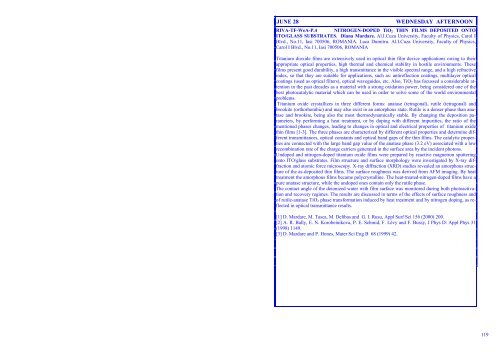Wüest M. 51 Wykes M. 82 Yamaguchi M. 17 Ybarra G. 129 Yubero F ...
Wüest M. 51 Wykes M. 82 Yamaguchi M. 17 Ybarra G. 129 Yubero F ...
Wüest M. 51 Wykes M. 82 Yamaguchi M. 17 Ybarra G. 129 Yubero F ...
You also want an ePaper? Increase the reach of your titles
YUMPU automatically turns print PDFs into web optimized ePapers that Google loves.
JUNE 28 WEDNESDAY AFTERNOON<br />
RIVA-TF-WeA-P.4 NITROGEN-DOPED TiO 2 THIN FILMS DEPOSITED ONTO<br />
ITO/GLASS SUBSTRATES. Diana Mardare. Al.I.Cuza University, Faculty of Physics, Carol I<br />
Blvd., No.11, Iasi 700506, ROMANIA. Luca Dumitru. Al.I.Cuza University, Faculty of Physics,<br />
Carol I Blvd., No.11, Iasi 700506, ROMANIA<br />
Titanium dioxide films are extensively used in optical thin film device applications owing to their<br />
appropriate optical properties, high thermal and chemical stability in hostile environments. These<br />
films present good durability, a high transmittance in the visible spectral range, and a high refractive<br />
index, so that they are suitable for applications, such as: antireflection coatings, multilayer optical<br />
coatings (used as optical filters), optical waveguides, etc. Also, TiO 2 has focussed a considerable attention<br />
in the past decades as a material with a strong oxidation power, being considered one of the<br />
best photocatalytic material which can be used in order to solve some of the world environmental<br />
problems.<br />
Titanium oxide crystallizes in three different forms: anatase (tetragonal), rutile (tetragonal) and<br />
brookite (orthorhombic) and may also exist in an amorphous state. Rutile is a denser phase than anatase<br />
and brookite, being also the most thermodynamically stable. By changing the deposition parameters,<br />
by performing a heat treatment, or by doping with different impurities, the ratio of the<br />
mentioned phases changes, leading to changes in optical and electrical properties of titanium oxide<br />
thin films [1-3]. The three phases are characterized by different optical properties and determine different<br />
transmittances, optical constants and optical band gaps of the thin films. The catalytic properties<br />
are connected with the large band gap value of the anatase phase (3.2 eV) associated with a low<br />
recombination rate of the charge carriers generated in the surface area by the incident photons.<br />
Undoped and nitrogen-doped titanium oxide films were prepared by reactive magnetron sputtering<br />
onto ITO/glass substrates. Film structure and surface morphology were investigated by X-ray diffraction<br />
and atomic force microscopy. X-ray diffraction (XRD) studies revealed an amorphous structure<br />
of the as-deposited thin films. The surface roughness was derived from AFM imaging. By heat<br />
treatment the amorphous films became polycrystalline. The heat-treated-nitrogen-doped films have a<br />
pure anatase structure, while the undoped ones contain only the rutile phase.<br />
The contact angle of the deionized water with film surface was monitored during both photoactivation<br />
and recovery regimes. The results are discussed in terms of the effects of surface roughness and<br />
of rutile-anatase TiO 2 phase transformation induced by heat treatment and by nitrogen doping, as reflected<br />
in optical transmittance results.<br />
[1] D. Mardare, M. Tasca, M. Delibas and G. I. Rusu, Appl Surf Sci 156 (2000) 200.<br />
[2] A. R. Bally, E. N. Korobeinikova, P. E. Schmid, F. Lévy and F. Bussy, J Phys D: Appl Phys 31<br />
(1998) 1149.<br />
[3] D. Mardare and P. Hones, Mater Sci Eng B 68 (1999) 42.<br />
119
















